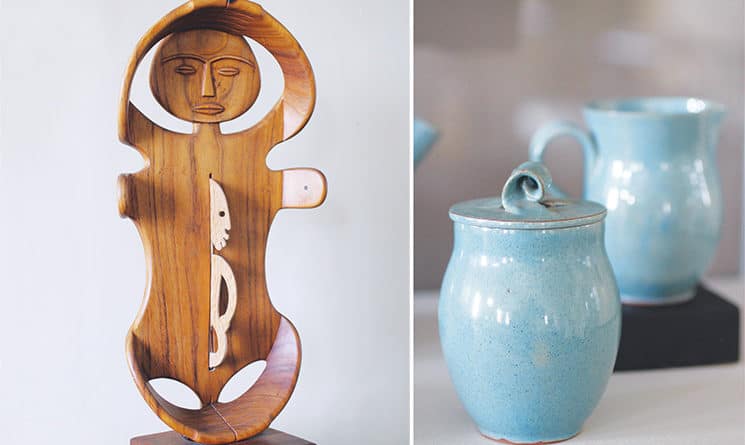Above: wood sculpture by Edwin Scheier, collection of Brian and Stephanie Fischer; sugar bowl by Mary Scheier, on loan from the League of New Hampshire Craftsmen
Discover Portsmouth reflects on the legacy of mid-century modern artists
Ed and Mary Scheier
words and photos by Chloe Kanner
Ed and Mary Scheier were married for 70 years, teaching, traveling, and creating art. When asked, Ed would say their pottery was their children.
They were a leading husband and wife team in the revival of American crafts and the mid-century modern movement, and during that time, the Seacoast was their home.
In the affluent postwar years, people started decorating new houses with a forward-looking style. Modern art and furniture was exhibited in arrangements that defined the ideal American home. And that often included pottery, paintings, sculpture, or textiles designed by the Scheiers.
“Ed and Mary Scheier: Mid-century Modern New Hampshire Artists” is one of the two remarkable exhibits this season at Discover Portsmouth. The other is an expansive retrospective of the arts and crafts produced by members of the New Hampshire Art Association and League of New Hampshire Craftsmen. Both open on May 1 and remain on display until Oct. 2.
These must-see exhibits leave no room for doubt about the legacy of the Scheiers and the significance of the time period in which they lived locally. The gallery is filled with era-defining arts and crafts.
a sculpture in the retrospective exhibit on the second floor of Discover Portsmouth
On the main floor, there are more than 80 pieces by the Scheiers, as well as some of the art they collected.
“Between the art the Scheiers owned on the walls of their Durham home and those in the retrospectives, there will be more mid-century modern art of the ’40s to ’60s than has been seen in the Seacoast since that time,” said Richard Candee, president of the Portsmouth Historical Society board of trustees.
The mid 20th century was a highpoint in the state’s creative economy and reputation among artists, thanks to government support for the arts. During the Depression, officials helped advance the industry by funding the League of Craftsmen.
In the next decade, the league also received support from the University of New Hampshire to recruit top artisans, including the Scheiers. Teachers were needed as veterans sought their degrees and interest in crafts increased. In addition to the pay, artists like the Scheiers benefited from studio space and inspirational sabbaticals. They moved to Durham in 1940, and for the next 20 years, Ed taught at UNH while Mary was an artist-in-residence.
Mary threw functional ware, sometimes hundreds of pieces in a day, and Ed glazed it. Her pottery is thin and fine, inspired by classic china. In one corner of the exhibit, Mary demonstrates her technique in a video from 1948. She’s considered a pioneer in modern studio pottery.
Ed threw, designed, and decorated larger sculptural pieces. His platters and vases show tribal imagery, a theme throughout his career, in part inspired by Mexico, where they lived for 10 years. Abstract representations of rebirth and connectedness can be found in his work. He also made wood sculptures, block prints, and encaustic paintings textured with gritty pigments. He meticulously designed tapestries and oversaw the weaving.
pottery by Ed Scheier: vessel (left), private collection of Joan Brownstein; vessel (middle), UNH Special Collections; platter (right), on loan from League of N.H. Craftsmen
The couple worked side by side until their deaths in 2007 and 2008, when they were in their 90s. Their work is represented in about 30 museums, with significant collections at UNH and the Currier Museum of Art in Manchester.
As part of the exhibit, there’s an example of how artwork by the Scheiers would have been arranged with furniture in one of the many craft shows they exhibited in. Ed’s floor vase and woven tapestry complement a kidney-shaped table and leather sling chair.
The exhibit upstairs provides regional context by highlighting two organizations important to the Scheiers. Both artists were employed by the League of New Hampshire Craftsmen, and Ed was active in the New Hampshire Art Association, which is now celebrating its 75th year. The retrospective also focuses on the mid-century years and many other parents of modernism.
A private gala opening is set for Thursday, April 30, from 5:30 to 8 p.m. Tickets are $75 for non-members, available at portsmouthhistory.org. Discover Portsmouth is located at 10 Middle St., Portsmouth.

